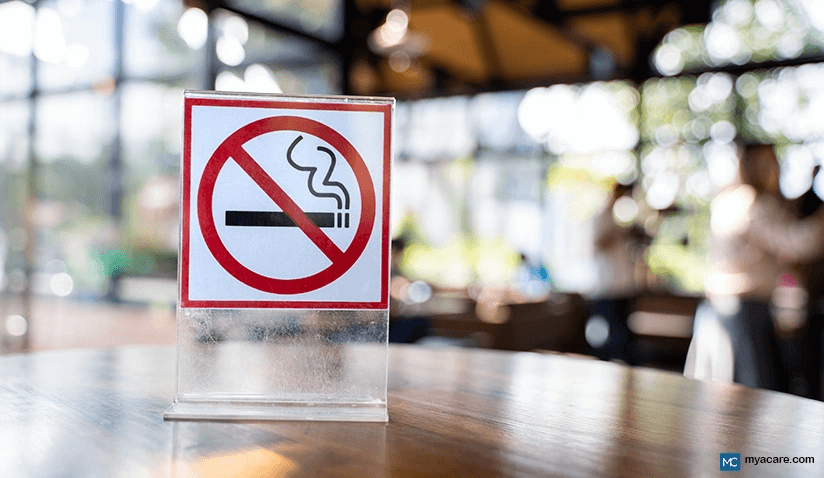Effects of Smoking on Oral Health

Article Updated 27 July 2021
Inhaling of tobacco products has deleterious effects on individuals. The nicotine present in tobacco smoke is highly addictive and may lead individuals to continue smoking. Smokers remain at high risk of developing several diseases such as COPD (Chronic obstructive pulmonary disease), cancer, heart disease, stroke, diabetes, eye diseases, and immune system-related diseases. Smoking is estimated to cause more than 480,000 deaths per year in the US (one in five deaths). Research suggests that individuals who smoke regularly die 10 years earlier than people who never smoked. Besides affecting general health, smoking causes harmful effects on oral health.
In this article, we discuss the mechanism involved in nicotine addiction, the impact of smoking on oral health, and the possible treatment options.
The mechanism involving nicotine addiction
Tobacco products have about 7000 chemicals, including nicotine, tar, carbon monoxide, acetaldehyde, and N-nitrosamines. Of these chemicals, nicotine is the component responsible for addiction. An average smoker inhales ~1-2 mg of nicotine per cigarette. Cigarette smoking rapidly increases the levels of nicotine in the blood that slowly enters the brain. In the brain, nicotine activates centers that regulate the feeling of pleasure. This long-term brain change due to continuous exposure to nicotine causes addiction.
Impact of smoking on oral health
Following are the effects of smoking on oral health:
- Increased likelihood of oral cancer
- Gum diseases
- Delayed wound healing after tooth removal or gum surgery
- Failure of dental implant procedures
- Stained or discolored teeth
- Malodor
- Increased accumulation of tartar
- Other conditions such as fungal infection, smoker’s melanosis, and smoker’s palate
Increased likelihood of oral cancer
Cigarette smoke comprises of nicotine, tar, carbon monoxide, and other carcinogens such as benzopyrene and nitrosamines. These chemicals are inhaled through active or passive smoking and dissolve in oral fluids to enter the systemic circulation. After entering the systemic circulation, they alter the immunity and increase the risk of cancer by interrupting the function of the normal cell cycle and tumor suppressor genes. Smoking also activates the production of free radicals which damage the DNA and cause mutations, further increasing the risk of oral cancer.
Smoking is associated with precancerous lesions such as leukoplakia and erythroplakia which have the potential to transform into cancer over some time. These lesions are present on the inner lining of the oral cavity and are smooth, nodular, white in appearance or accompanied with redness around it. This condition may disappear after termination of smoking over 8-12 months.
Gum diseases
Smoking is considered a high-risk factor for gum or periodontal diseases. Research suggests that smokers with consumption of 10 cigarettes per day over 15 years are more susceptible to developing gum diseases. Nicotine significantly impairs the function of defense cells in tooth supporting tissues (e.g., gums, bone) and activates several harmful chemicals which destroy them. This leads to loss of teeth and worsens the disease. Heavy smokers are at a 3 times higher risk of experiencing tooth loss than non-smokers.
Delayed wound healing after tooth removal or gum surgery
Wound healing is compromised in smokers compared to non-smokers. The tooth-supporting tissues (e.g., gums, bone) in smokers are exposed to nicotine and other chemicals. These chemicals or toxins in tobacco smoke inhibit the cellular functions responsible for the healing of tissues, therefore, smokers respond less favorably to healing after periodontal therapy (surgical or non-surgical gum surgery), tissue regeneration procedures, tooth removal, and other surgical procedures.
Failure of dental implant procedures
Dental implants are screw-shaped metal posts inserted into the jaw bone on which artificial teeth are mounted. For successful implant therapy, adhesion (osseointegration) between the jaw bone and dental implant is a prerequisite. Several studies suggest that implant failure is more common among smokers than non-smokers. This is due to the constriction (narrowing) of blood vessels in gums which deprive tissues and the jaw bone of enough oxygen supply needed to sustain and heal. This hampers the attachment of the implant to the bone, leading to a failed implant procedure.
Stained or discolored teeth
Smoking causes brown or black discoloration of teeth, tooth-colored fillings, and dentures. This is due to the presence of nicotine and tar in the smoke. Discoloration of teeth can affect the appearance of an individual and may create social embarrassment.
Malodor
The volatile Sulphur compounds present in tobacco result in malodor. Additionally, decreased saliva in the mouth due to smoking further contributes to malodor.
Increased accumulation of tartar
Long-term smoking increases the accumulation of tartar (calculus) on the tooth surface. Research suggests that smokers are more likely to develop tartar than non-smokers.
Other conditions
Smoking for a long time alters the taste and smell sensations and increases the risk of developing a black, hairy tongue. Smokers are also susceptible to fungal infections such as oral candidiasis. Tobacco present in the smoke increases the production of oral melanocytes (pigment producing cells). This leads to black discoloration of gums and lips, and the inner aspect of cheeks, also known as a smoker’s melanosis. Meanwhile, heavy pipe, cigarette, or cigar smokers also develop changes in the mucosa (inner lining) of the palate. These changes can be seen as white plaque, in combination with multiple elevated red dots indicative of inflamed ducts of the minor salivary gland.
Treatment:
Quitting smoking is the only way to reduce the risk of developing lethal general and oral health conditions. Research suggests that the regression of the oral conditions is observed on termination of smoking. Quitting smoking may be difficult due to addiction, but several strategies are available to assist individuals in quitting smoking. Smoking cessation can be classified into two types:
- Medicinal therapy: This includes nicotine replacement therapy and non-nicotine therapy. Nicotine replacement therapy aims at reducing the craving or withdrawal symptoms for nicotine using nicotine gum, transdermal patch, nasal spray, tablets, and lozenges. These contain a limited quantity of nicotine without any harmful chemicals. Meanwhile, non-nicotine therapy includes the use of several drugs (such as varenicline, bupropion, and nortriptyline) which help in quitting smoking.
- Behavioral therapy: Behavioral therapy conducted by specialized counselors can help in smoking cessation in several individuals. These counseling sessions strengthen the determination to quit smoking and help engage the individual’s mind in several activities to overcome the urge to smoke.
To search for the best healthcare providers offering dentistry, please use our search engine. We currently have providers in India, Malaysia, Singapore, Spain, Thailand, Turkey, the UAE, the UK and the United States
To search for the best healthcare providers worldwide, please use the Mya Care search engine.

Dr. Shilpy Bhandari is an experienced dental surgeon, with specialization in periodontics and implantology. She received her graduate and postgraduate education from Rajiv Gandhi University of Health Sciences in India. Besides her private practice, she enjoys writing on medical topics. She is also interested in evidence-based academic writing and has published several articles in international journals.
References:
Featured Blogs



